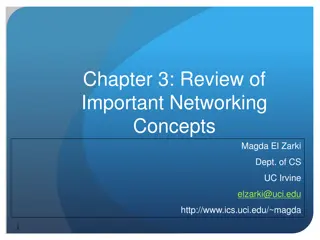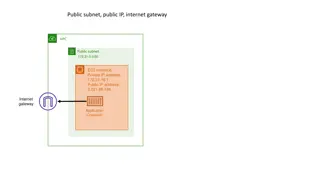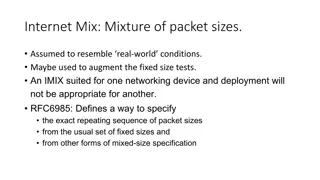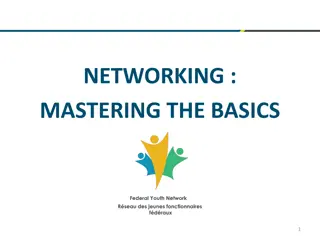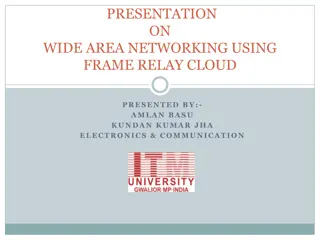
Networking Basics and Java Networking Concepts
Explore the fundamentals of computer networking, Internet Protocol (IP) addresses, networking protocols, port numbers, and MAC addresses. Learn how Java Networking facilitates sharing resources and connecting computing devices. Discover the significance of IP addresses and the role of Domain Name Servers (DNS) in translating hostnames. Understand the difference between TCP and UDP protocols for reliable and fast communication. Gain insights into the importance of port numbers in identifying applications and the unique identifiers of MAC addresses.
Download Presentation

Please find below an Image/Link to download the presentation.
The content on the website is provided AS IS for your information and personal use only. It may not be sold, licensed, or shared on other websites without obtaining consent from the author. If you encounter any issues during the download, it is possible that the publisher has removed the file from their server.
You are allowed to download the files provided on this website for personal or commercial use, subject to the condition that they are used lawfully. All files are the property of their respective owners.
The content on the website is provided AS IS for your information and personal use only. It may not be sold, licensed, or shared on other websites without obtaining consent from the author.
E N D
Presentation Transcript
Chapter Five Networking in Java 1
Networking Basics Computer networking is to send and receive messages among computers on the Internet To browse the Web or send email, your computer must be connected to the Internet. Your computer can connect to the Internet through an Internet Service Provider (ISP) using a dialup, DSL, or cable modem, or through a local area network (LAN). Java Networking is a concept of connecting two or more computing devices together so that we can share resources. Advantage of Java Networking sharing resources centralize software management When a computer needs to communicate with another computer, it needs to know an IP address. 2
Networking Basics Internet Protocol (IP) addresses Uniquely identifies the computer on the Internet. or IP address is a unique number assigned to a node of a network. It is a logical address that can be changed. Every host on Internet has a unique IP address An IP address consists of four dotted decimal numbers ranging from 0 and 255, such as 143.89.40.46, 203.184.197.198 203.184.197.196, 203.184.197.197, 127.0.0. Since it is difficult to remember IP address, there is a special server called Domain Name Server(DNS), which translates hostname to IP address Example: DomainName: www.bdu.edu.et , www.google.com, localhost IP Addresess: 10.1.25.16 One domain name can correspond to multiple internet addresses: www.yahoo.com: 66.218.70.49; 66.218.70.50; 66.218.71.80; 66.218.71.84; Domain Name Server (DNS) maps names to numbers 216.58.207.4 127.0.0.1 3
Networking Basics A protocols is a set of rules that facilitate communications between machines or hosts. Examples: HTTP: HyperText Transfer Protocol FTP: File Transfer Protocol SMTP: Simple Message Transfer Protocol TCP: Transmission Control Protocol UDP: User Datagram Protocol, good for, e.g., video delivery) TCP: Connection-oriented protocol enables two hosts to establish a connection and exchange streams of data. Acknowledgement is send by the receiver. So, it is reliable but slow Uses Stream-based communications guarantees delivery of data and also guarantees that packets will be delivered in the same order in which they were sent. UDP: Enables connectionless communication Acknowledgement is not sent by the receiver. So it is not reliable but fast. Uses packet-based communications. Cannot guarantee lossless transmission. 4
Networking Basics Port Number The port number is used to uniquely identify different applications. It acts as a communication endpoint between applications. The port number is associated with the IP address for communication between two applications. Port numbers are ranging from 0 to 65536, but port numbers 0 to 1024 are reserved for privileged services. Many standard port numbers are pre-assigned time of day 13, ftp 21, telnet 23, smtp 25, http 80 You can choose any port number that is not currently used by other programs. IP address + port number = "phone number " for service or application MAC Address MAC (Media Access Control) Address is a unique identifier of NIC (Network Interface Controller). A network node can have multiple NIC but each with unique MAC. 5
Networking Basics Client-Server interaction Communication between hosts is two-way, but usually the two hosts take different roles. Server waits for client to make request Server registered on a known port with the host ("public phone number") Listens for incoming client connections Client "calls" server to start a conversation Client making calls uses hostname/IP address and port number Sends request and waits for response Standard services always running ftp, http, smtp, etc. server running on host using expected port Server offers shared resource (information, database, files, printer, compute power) to clients 6
Socket-Level Programming Java Socket programming is used for communication between the applications running on different JRE. Java Socket programming can be connection-oriented or connection- less. Socket and ServerSocket classes are used for connection-oriented socket programming. DatagramSocket and DatagramPacket classes are used for connection-less socket programming. Java socket programming provides facility to share data between different computing devices. Send and receive data using streams OutputStream InputStream Client Server InputStream OutputStream 7
Client/Server Communications Java provides the ServerSocket class for creating a server socket and the Socket class for creating a client socket. Two programs on the Internet communicate through a server socket and a client socket using I/O streams. Sockets are the endpoints of logical connections between two hosts and can be used to send and receive data. Network programming usually involves a server and one or more clients. The client sends requests to the server, and the server responds. The client begins by attempting to establish a connection to the server. The server can accept or deny the connection. Once a connection is established, the client and the server communicate through sockets. The server must be running when a client attempts to connect to the server. The server waits for a connection request from a client. 8
Client/Server Communications The statements needed to create sockets on a server and a client are shown below. 9
Server Sockets To establish a server, you need to create a server socket and attach it to a port, which is where the server listens for connections. The port identifies the TCP service on the socket. The following statement creates a server socket serverSocket: ServerSocket serverSocket = new ServerSocket(port); Attempting to create a server socket on a port already in use would cause the java.net.BindException. 10
Client Sockets After a server socket is created, the server can use the following statement to listen for connections: Socket socket = serverSocket.accept(); This statement waits until a client connects to the server socket. The client issues the following statement to request a connection to a server: Socket socket = new Socket(serverName, port); This statement opens a socket so that the client program can communicate with the server. 11
Client Sockets serverName is the server s Internet host name or IP address. The following statement creates a socket on the client machine to connect to the host 130.254.204.33 at port 8000: Socket socket = new Socket("130.254.204.33", 8000) Alternatively, you can use the domain name to create a socket, as follows: Socket socket = new Socket( www.google.com", 8000); When you create a socket with a host name, the JVM asks the DNS to translate the host name into the IP address. 12
Data Transmission through Sockets After the server accepts the connection, communication between the server and client is conducted the same as for I/O streams. The statements needed to create the streams and to exchange data between them are shown in the Figure below. 13
Data Transmission through Sockets To get an input stream and an output stream, use the getInputStream() and getOutputStream() methods on a socket object. For example, the following statements create an InputStream stream called input and an OutputStream stream called output from a socket: InputStream OutputStream output = socket.getOutputStream(); input = socket.getInputStream(); DataInputStream in = new DataInputStream(input); DataOutputStream out = new DataOutputStream(output)); 15
Data Transmission through Sockets The InputStream and OutputStream streams are used to read or write bytes. You can use DataInputStream, DataOutputStream, BufferedReader, and PrintWriter to wrap on the InputStream and OutputStream to read or write data, such as int, double, or String. The following statements, for instance, create the DataInputStream stream input and the DataOutputStream stream output to read and write primitive data values: DataInputStream input = new DataInputStream (socket.getInputStream()); DataOutputStream output = new DataOutputStream (socket.getOutputStream()); The server can use input.readDouble() to receive a double value from the client, and output.writeDouble(d) to send the double value d to the client. Binary I/O is more efficient than text I/O because text I/O requires encoding and decoding. Therefore, it is better to use binary I/O for transmitting data between a server and a client to improve performance. 16
A Client/Server Example Problem: Write a client and a server program that the client sends data to a server. The server receives the data, uses it to produce a result, and then sends the result back to the client. The client displays the result on the console. In this example, the data sent from the client is the radius of a circle, and the result produced by the server is the area of the circle.The client sends the radius to the server; the server computes the area and sends it to the client. compute area radius Server Client area 17
A Client/Server Example The client sends the radius through a DataOutputStream on the output stream socket, and the server receives the radius through the DataInputStream on the input stream socket, as shown in Figure (A) below. The server computes the area and sends it to the client through a DataOutputStream on the output stream socket, and the client receives the area through a DataInputStream on the input stream socket, as shown in Figure (B) below. Client Server Client Server radius radius area area DataOutputStream DataInputStream DataOutputStream DataOutputStream socket.getOutputStream socket.getInputStream socket.getOutputStream socket.getOutputStream socket socket socket socket Network Network (A) (B) 18
A Client/Server Example compute area radius Server Client area Note: Start the server, then the client. 19
A Client/Server Example import java.io.*; import java.net.*; import java.util.*; import java.awt.*; import javax.swing.*; public class Server extends JFrame { // Text area for displaying contents private JTextArea jta = new JTextArea(); public static void main(String[] args) { new Server(); } public Server() { // Place text area on the frame setLayout(new BorderLayout()); add(new JScrollPane(jta), BorderLayout.CENTER); setTitle("Server"); setSize(500, 300); setDefaultCloseOperation(JFrame.EXIT_ON_CLOSE); setVisible(true); // It is necessary to show the frame here! 20
A Client/Server Example try { // Create a server socket ServerSocket serverSocket = new ServerSocket(8000); jta.append("Server started at " + new Date() + '\n' ); // Listen for a connection request Socket socket = serverSocket.accept(); // Create data input and output streams DataInputStream inputFromClient = new DataInputStream(socket.getInputStream()); DataOutputStream outputToClient = new DataOutputStream(socket.getOutputStream()); while (true) { // Receive radius from the client double radius = inputFromClient.readDouble(); double area = radius * radius * Math.PI; // Compute area // Send area back to the client outputToClient.writeDouble(area); jta.append("Radius received from client: " + radius + '\n' ); jta.append("Area found: " + area + '\n' ); } } catch(IOException ex) { System.err.println(ex); } } } 21
A Client/Server Example import java.io.*; import java.net.*; import java.awt.*; import java.awt.event.*; import javax.swing.*; public class Client extends JFrame { // Text field for receiving radius private JTextField jtf = new JTextField(); // Text area to display contents private JTextArea jta = new JTextArea(); // IO streams private DataOutputStream toServer; private DataInputStream fromServer; public static void main(String[] args) { new Client(); } public Client() { // Panel p to hold the label and text field JPanel p = new JPanel(); p.setLayout(new BorderLayout()); p.add(new JLabel("Enter radius"), BorderLayout.WEST); p.add(jtf, BorderLayout.CENTER); jtf.setHorizontalAlignment(JTextField.RIGHT); setLayout(new BorderLayout()); add(p, BorderLayout.NORTH); add(new JScrollPane(jta), BorderLayout.CENTER); jtf.addActionListener(new TextFieldListener()); setTitle("Client"); setSize(500, 300); setDefaultCloseOperation(JFrame.EXIT_ON_CLOSE); setVisible(true); // It is necessary to show the frame here! 22
A Client/Server Example try { // Create a socket to connect to the server Socket socket = new Socket("localhost", 8000); // Socket socket = new Socket("130.254.204.33", 8000); Socket socket = new Socket("liang.armstrong.edu", 8000); // Create an input stream to receive data from the server fromServer = new DataInputStream(socket.getInputStream()); // Create an output stream to send data to the server toServer = new DataOutputStream(socket.getOutputStream()); } catch (IOException ex) { jta.append(ex.toString() + '\n' ); } } 23
A Client/Server Example private class TextFieldListener implements ActionListener { @Override public void actionPerformed(ActionEvent e) { try { // Get the radius from the text field double radius = Double.parseDouble(jtf.getText().trim()); // Send the radius to the server toServer.writeDouble(radius); toServer.flush(); // Get area from the server double area = fromServer.readDouble(); // Display to the text area jta.append("Radius is " + radius + "\n"); jta.append("Area received from the server is +area+ '\n'); } catch (IOException ex) { System.err.println(ex); } } } } 24
The InetAddress Class The server program can use the InetAddress class to obtain the information about the IP address and host name for the client. You can use the InetAddress class to find the client s host name and IP address. You can use the statement shown below to create an instance of InetAddress for the client on a socket. InetAddress inet = socket.getInetAddress(); Next, you can display the client s host name and IP address, as follows: System.out.println("Client's host name is " + inet.getHostName()); System.out.println("Client's IP Address is " + inet.getHostAddress()); You can also create an instance of InetAddress from a host name or IP address using the static getByName() method. For example, the following statement creates an InetAddress for the host www.bdu.edu.et. InetAddress address = InetAddress.getByName( www.bdu.edu.et"); 25
Example: The InetAddress Class import java.net.*; public class IdentifyHostNameIP { public static void main(String[] args) { try { InetAddress address = InetAddress.getByName("www.bdu.edu.et"); System.out.print("Host name:"+ address.getHostName()); System.out.println("IP address:"+ address.getHostAddress()); } catch (UnknownHostException ex) { System.err.println("Unknown host or IP address www.bdu.edu.et "); } } } 26
Serving Multiple Clients A server can serve multiple clients. The connection to each client is handled by one thread. Multiple clients are quite often connected to a single server at the same time. You can use threads to handle the server's multiple clients simultaneously. Simply create a thread for each connection. Here is how the server handles the establishment of a connection: while (true) { Socket socket = serverSocket.accept(); Thread thread = new ThreadClass(socket); thread.start(); } The server socket can have many connections. Each iteration of the while loop creates a new connection. Whenever a connection is established, a new thread is created to handle communication between the server and the new client; and this allows multiple connections to run at the same time. 27
Example: Serving Multiple Clients Note: Start the server first, then start multiple clients. 28
Example: Serving Multiple Clients import java.io.*; import java.net.*; import java.util.*; import java.awt.*; import javax.swing.*; public class MultiThreadServer extends JFrame { // Text area for displaying contents private JTextArea jta = new JTextArea(); public static void main(String[] args) { new MultiThreadServer(); } public MultiThreadServer() { // Place text area on the frame setLayout(new BorderLayout()); add(new JScrollPane(jta), BorderLayout.CENTER); setTitle("MultiThreadServer"); setSize(500, 300); setDefaultCloseOperation(JFrame.EXIT_ON_CLOSE); setVisible(true); // It is necessary to show the frame here! try { // Create a server socket ServerSocket serverSocket = new ServerSocket(8000); jta.append("MultiThreadServer started at " + new Date() + '\n' ); // Number a client int clientNo = 1; 29
Example: Serving Multiple Clients while (true) { // Listen for a new connection request Socket socket = serverSocket.accept(); // Display the client number jta.append("Starting thread for client " + clientNo + " at " + new Date() + '\n' ); // Find the client's host name and IP address InetAddress inetAddress = socket.getInetAddress(); jta.append("Client " + clientNo + "'s host name is + inetAddress.getHostName() + "\n"); jta.append("Client " + clientNo + "'s IP Address is + inetAddress.getHostAddress() + "\n"); // Create a new thread for the connection HandleAClient task = new HandleAClient(socket); // Start the new thread new Thread(task).start(); // Increment clientNo clientNo++; } } catch(IOException ex) { System.err.println(ex); } } 30
Example: Serving Multiple Clients // Inner class // Define the thread class for handling new connection class HandleAClient implements Runnable { private Socket socket; // A connected socket /** Construct a thread */ public HandleAClient(Socket socket) { this.socket = socket; } @Override /** Run a thread */ public void run(){ try { // Create data input and output streams DataInputStream inputFromClient = new DataInputStream(socket.getInputStream()); DataOutputStream outputToClient = new DataOutputStream(socket.getOutputStream()); // Continuously serve the client while (true) { // Receive radius from the client double radius = inputFromClient.readDouble(); // Compute area double area = radius * radius * Math.PI; // Send area back to the client outputToClient.writeDouble(area); jta.append("radius received from client: " + radius + '\n' ); jta.append("Area found: " + area + '\n' ); } } catch(IOException e) { System.err.println(e); } } } } 31
Sending and Receiving Objects A program can send and receive objects from another program. In the preceding examples, you learned how to send and receive data of primitive types. You can also send and receive objects using ObjectOutputStream and ObjectInputStream on socket streams. To enable passing, the objects must be serializable. The following example demonstrates how to send and receive objects. 32
Example: Passing Objects in Network Programs Write a program that collects student information from a client and send them to a server. Passing student information in an object. Client Server student object student object out.writeObject(student) in.readObject() out: ObjectOutputStream in: ObjectInputStream socket.getOutputStream socket.getInputStream socket socket Network 33
Example: Passing Objects in Network Programs public class StudentAddress implements java.io.Serializable { private String name; private String street; private String city; private String state; private String zip; public StudentAddress(String name, String street, String city, String state, String zip) { this.name = name; this.street = street; this.city = city; this.state = state; this.zip = zip; } public String getName() { return name; } public String getStreet() { return street; } public String getCity() { return city; } public String getState() { return state; } public String getZip() { return zip; } } 34
Example: Passing Objects in Network Programs import java.io.*; import java.net.*; import java.awt.*; import java.awt.event.*; import javax.swing.*; import javax.swing.border.*; public class StudentClient extends JApplet { private JTextField jtfName = new JTextField(32); private JTextField jtfStreet = new JTextField(32); private JTextField jtfCity = new JTextField(20); private JTextField jtfState = new JTextField(2); private JTextField jtfZip = new JTextField(5); // Button for sending a student's address to the server private JButton jbtRegister = new JButton("Register to the Server"); // Indicate if it runs as application private boolean isStandAlone = false; // Host name or IP address String host = "localhost"; public void init() { // Panel p1 for holding labels Name, Street, and City JPanel p1 = new JPanel(); p1.setLayout(new GridLayout(3, 1)); p1.add(new JLabel("Name")); p1.add(new JLabel("Street")); p1.add(new JLabel("City")); 35
Example: Passing Objects in Network Programs // Panel jpState for holding state JPanel jpState = new JPanel(); jpState.setLayout(new BorderLayout()); jpState.add(new JLabel("State"), BorderLayout.WEST); jpState.add(jtfState, BorderLayout.CENTER); // Panel jpZip for holding zip JPanel jpZip = new JPanel(); jpZip.setLayout(new BorderLayout()); jpZip.add(new JLabel("Zip"), BorderLayout.WEST); jpZip.add(jtfZip, BorderLayout.CENTER); // Panel p2 for holding jpState and jpZip JPanel p2 = new JPanel(); p2.setLayout(new BorderLayout()); p2.add(jpState, BorderLayout.WEST); p2.add(jpZip, BorderLayout.CENTER); // Panel p3 for holding jtfCity and p2 JPanel p3 = new JPanel(); p3.setLayout(new BorderLayout()); p3.add(jtfCity, BorderLayout.CENTER); 36
Example: Passing Objects in Network Programs p3.add(p2, BorderLayout.EAST); // Panel p4 for holding jtfName, jtfStreet, and p3 JPanel p4 = new JPanel(); p4.setLayout(new GridLayout(3, 1)); p4.add(jtfName); p4.add(jtfStreet); p4.add(p3); // Place p1 and p4 into StudentPanel JPanel studentPanel = new JPanel(new BorderLayout()); studentPanel.setBorder(new BevelBorder(BevelBorder.RAISED)); studentPanel.add(p1, BorderLayout.WEST); studentPanel.add(p4, BorderLayout.CENTER); // Add the student panel and button to the applet add(studentPanel, BorderLayout.CENTER); add(jbtRegister, BorderLayout.SOUTH); // Register listener jbtRegister.addActionListener(new ButtonListener()); // Find the IP address of the Web server if (!isStandAlone) host = getCodeBase().getHost(); } /** Handle button action */ private class ButtonListener implements ActionListener { @Override public void actionPerformed(ActionEvent e) { try { // Establish connection with the server Socket socket = new Socket(host, 8000); 37
Example: Passing Objects in Network Programs // Create an output stream to the server ObjectOutputStream toServer = new ObjectOutputStream(socket.getOutputStream()); // Get text field String name = jtfName.getText().trim(); String street = jtfStreet.getText().trim(); String city = jtfCity.getText().trim(); String state = jtfState.getText().trim(); String zip = jtfZip.getText().trim(); // Create a StudentAddress object and send to the server StudentAddress s = new StudentAddress(name, street, city, state, zip); toServer.writeObject(s); } catch (IOException ex) { System.err.println(ex); } } } 38
Example: Passing Objects in Network Programs /** Run the applet as an application */ public static void main(String[] args) { // Create a frame JFrame frame = new JFrame("Register Student Client"); // Create an instance of the applet StudentClient applet = new StudentClient(); applet.isStandAlone = true; // Get host if (args.length == 1) applet.host = args[0]; // Add the applet instance to the frame frame.add(applet, BorderLayout.CENTER); // Invoke init() and start() applet.init(); applet.start(); // Display the frame frame.pack(); frame.setVisible(true); } } 39
Example: Passing Objects in Network Programs import java.io.*; import java.net.*; public class StudentServer { private ObjectOutputStream outputToFile; private ObjectInputStream inputFromClient; public static void main(String[] args) { new StudentServer(); } public StudentServer() { try { // Create a server socket ServerSocket serverSocket = new ServerSocket(8000); System.out.println("Server started "); // Create an object output stream outputToFile = new ObjectOutputStream( new FileOutputStream("student.dat", true)); while (true) { // Listen for a new connection request Socket socket = serverSocket.accept(); // Create an input stream from the socket inputFromClient = new ObjectInputStream(socket.getInputStream()); 40
Example: Passing Objects in Network Programs // Read from input Object object = inputFromClient.readObject(); // Write to the file outputToFile.writeObject(object); System.out.println("A new student object is stored"); } } catch(ClassNotFoundException ex) { ex.printStackTrace(); } catch(IOException ex) { ex.printStackTrace(); } finally { try { inputFromClient.close(); outputToFile.close(); } catch (Exception ex) { ex.printStackTrace(); } } } } 41
The URL Class Audio and images are stored in files. The java.net.URL class can be used to identify the files on the Internet. In general, a URL (Uniform Resource Locator) is a pointer to a "resource" on the World Wide Web. A resource can be something as simple as a file or a directory. You can create a URL object using the following constructor: public URL(String spec) throws MalformedURLException For example, the following statement creates a URL object for http://www.sun.com: try { URL url = new URL("http://www.sun.com"); } catch(MalformedURLException ex) { } 42
Creating a URL Instance To retrieve the file, first create a URL object for the file. For example, the following statement creates a URL object for http://www.cs.armstrong.edu/liang/index.html. URL url = new URL("http://www.cs.armstrong.edu/liang/index.html"); You can then use the openStream() method defined in the URL class to open an input stream to the file's URL. InputStream inputStream = url.openStream(); 43
The End!! 44


